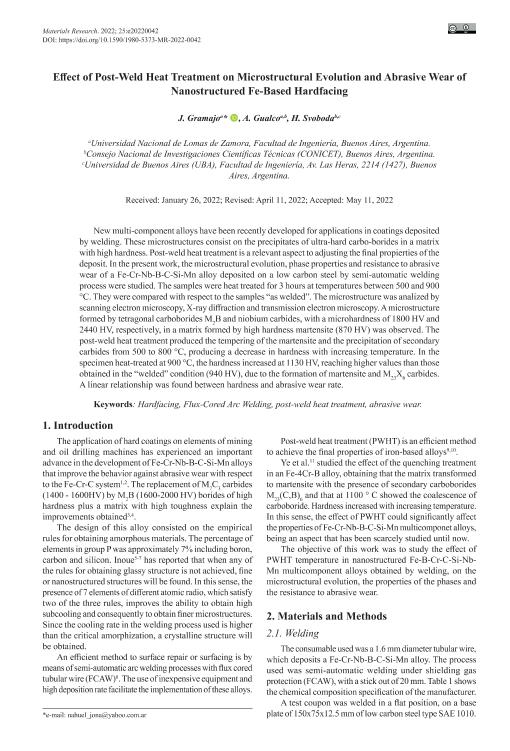Artículo
Effect of Post-Weld Heat Treatment on Microstructural Evolution and Abrasive Wear of Nanostructured Fe-Based Hardfacing
Fecha de publicación:
05/2022
Editorial:
Universidade Federal de São Carlos
Revista:
Materials Research
ISSN:
1516-1439
Idioma:
Inglés
Tipo de recurso:
Artículo publicado
Clasificación temática:
Resumen
New multi-component alloys have been recently developed for applications in coatings deposited by welding. These microstructures consist on the precipitates of ultra-hard carbo-borides in a matrix with high hardness. Post-weld heat treatment is a relevant aspect to adjusting the final propierties of the deposit. In the present work, the microstructural evolution, phase properties and resistance to abrasive wear of a Fe-Cr-Nb-B-C-Si-Mn alloy deposited on a low carbon steel by semi-automatic welding process were studied. The samples were heat treated for 3 hours at temperatures between 500 and 900°C. They were compared with respect to the samples "as welded". The microstructure was analized by scanning electron microscopy, X-ray diffraction and transmission electron microscopy. A microstructure formed by tetragonal carboborides M2B and niobium carbides, with a microhardness of 1800 HV and 2440 HV, respectively, in a matrix formed by high hardness martensite (870 HV) was observed. The post-weld heat treatment produced the tempering of the martensite and the precipitation of secondary carbides from 500 to 800°C, producing a decrease in hardness with increasing temperature. In the specimen heat-treated at 900°C, the hardness increased at 1130 HV, reaching higher values than those obtained in the "welded" condition (940 HV), due to the formation of martensite and M23X6 carbides. A linear relationship was found between hardness and abrasive wear rate.
Palabras clave:
ABRASIVE WEAR
,
FLUX-CORED ARC WELDING
,
HARDFACING
,
POST-WELD HEAT TREATMENT
Archivos asociados
Licencia
Identificadores
Colecciones
Articulos(INTECIN)
Articulos de INST.D/TEC.Y CS.DE LA ING."HILARIO FERNANDEZ LONG"
Articulos de INST.D/TEC.Y CS.DE LA ING."HILARIO FERNANDEZ LONG"
Citación
Gramajo, Jonathan Nahuel; Gualco, Agustín; Svoboda, Hernán Gabriel; Effect of Post-Weld Heat Treatment on Microstructural Evolution and Abrasive Wear of Nanostructured Fe-Based Hardfacing; Universidade Federal de São Carlos; Materials Research; 25; 5-2022; 1-9
Compartir
Altmétricas




